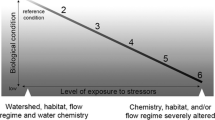Abstract
Strategic management and planning within estuaries seeks to identify a framework that enshrines sustainability. Any management initiative must address the issues of longterm change; physical, chemical and biological interactions; and system response (including socio-economic interactions). Achieving such a programme will need to take advantage of studies and research at a number of different spatial and temporal scales. These range from global climate change initiatives, through catchment and estuary wide studies to work on specific features (banks, mud flats, etc.). They necessarily consider changes over time scales of seconds to aeons. For strategic planning and management, thegoal is to be able to predict change, with a reasonable degree of confidence over a 20 to 50 year time horizon. Given the highly non-linear and complex adaptive nature of estuary systems, absolute predictions may not be possible. Rather, it will be necessary to identify probable/possible outcomes, or system states, as a basis for guiding management actions. This, in itself, will require managers and planners to move away from a prescriptive interventionist approach towards a more adaptive one.
Similar content being viewed by others
References
Anon. 2000a. I.A guide to prediction of morphological change within estuarine systems. EMPHASYS Consortium. Estuary Research Programme, Phase 1, HR Wallingford, Wallingford, TR 114; pp51.
Anon. (ABP Research). 2000b.Humber Estuary strategic geomorphological studies—Stage 2: Technical Report Report for the Environment Agency. Binnie, Black & Veatch, Leeds, UK.
Barham, P. 1997.Humber estuary flood defences: a strategic approach. Proceedings of the 32nd MAFF Conference of River and Coastal Engineers, pp. F.3.1.-F.3.10. MAFF, London, UK.
Capobianco, M., de Vriend, H., Nicholls, R. & Stive, M.J.F. 1999. Coastal area impact and vulnerability assessment: the point of view of a morphodynamic modeller.J. Coastal Res. 15:701–716.
Mayo, D.G. 1996.Error and the growth of experimental knowledge. The University of Chicago Press, London, UK.
Pethick, J.S. 1992.Strategic planning and coastal defence 27th River and Coastal Engineers Conference, pp. 3.1.1–3.1.7. MAFF, London, UK.
Pontee, N.I. & Townend, I.H. 1999a.An estuary cause-consequence model. 34th MAFF Conference of River and Coastal Engineers, pp. 5.2.1.-5.2.17. MAFF, London, UK.
Pontee, N.I. & Townend, I.H. 1999b. The development of a framework for estuary shoreline management plans. In:Coastal management: Integrating science, engineering and management, pp. 117–126. Thomas Telford, London, UK.
Townend, I.H. 1990. Frameworks for shoreline management.PIANC Bull. 71: 72–80.
Townend, I.H. 1992. Shoreline management: a question of definition. In:Coastal zone planning and management pp. 195–210. Thomas Telford, London, UK.
Townend, I.H. 2002. Marine science for strategic planning and management: The requirement for estuaries.J. Mar. Policy. 26: 209–219.
Townend, I.H. 2003.Coast and estuary behaviour systems Coastal Sediments '03: Crossing Disciplinary Boundaries. Proceedings of the Fifth International Symposium on Coastal Engineering and Science of Coastal Sediment Processes. East Meets West Productions (EMW) Inc. Corpus Christi, TX, US.
Townend, I.H. & Pethick, J. 2002. Estuarine flooding and managed retreat.Phil. Trans. R. Soc. Lond. A 360: 1–20.
Twonend, I.H. & Whitehead, P.A. 2003. A preliminary net sediment budget for the Humber Estuary.Sci. Total Environ. 314–316: 755–767.
Townend, I.H., Pethick, J., Balson, P., Roberts, B. & Young, R. 2000.The geomorphology of the Humber Estuary 35th MAFF Conference of River and Coastal Engineers, pp. 3.4.1–3.4.11. MAFF, London, UK.
Turner, R.K., Adger, W.N. & Lorenzoni, I. 1998. Towards integrated modelling and analysis in coastal zones: principles and practice. Land-ocean interactions in the coastal zone, International Project Office, LOICZ Reports and Studies No. 11. Texel, NL.
Author information
Authors and Affiliations
Corresponding author
Rights and permissions
About this article
Cite this article
Townend, I.H. Identifying change in estuaries. J Coast Conserv 10, 5–12 (2004). https://doi.org/10.1652/1400-0350(2004)010[0005:ICIE]2.0.CO;2
Received:
Revised:
Accepted:
Issue Date:
DOI: https://doi.org/10.1652/1400-0350(2004)010[0005:ICIE]2.0.CO;2




